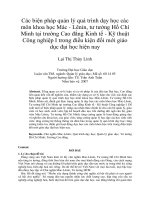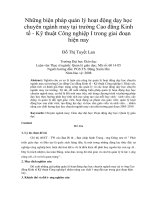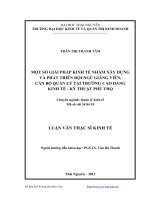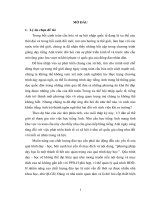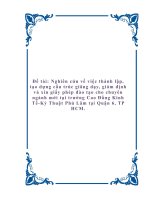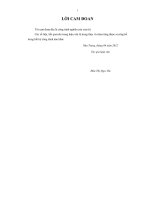ử dụng các chủ đề mang tính tranh cãi nhằm tăng cường sự tham gia của sinh viên trong các giờ học nói tiếng Anh tại trường Cao đẳng Kinh tế - Kỹ thuật Trung Ươn
Bạn đang xem bản rút gọn của tài liệu. Xem và tải ngay bản đầy đủ của tài liệu tại đây (1.46 MB, 55 trang )
iv
LIST OF TABLES AND FIGURES
Table 2.1: Students’ profiles
Table 3.1: The degrees of students’ participation before the experiment
Table 3.2: Students’ purposes of learning English
Table 3.3: Students’ learning styles in the two classes
Table 3.4: Students’ levels of participation before and after the experiment
Figure 3.1: Students’ levels of participation in group discussion in Class KT1A
Figure 3.2: Students’ level of participation in group discussion in Class KT1B
Figure 3.3: Students’ levels of participation in debating in Class KT1A
Figure 3.4: Students’ levels of participation in debating in Class KT1B
Figure 3.5: Students’ levels of participation before the experiment
Figure 3.6: Students’ levels at the end of the experiment
v
ABBREVIATIONS
NETC: National Economic Technical College
CLT: Communicative Language Teaching
ESL: English as Second Language
1
PART 1: INTRODUCTION
The first chapter of this thesis is to introduce the rationale, the aims of the study as well as the
research questions which the study was to carry out to find out the answers. It also presents the
scope of the study, an overview of the methods employed to conduct the research, the
significance of the study as well as its design.
1. Rationale of the study
As a foreign language in Vietnam, English is learned seriously by many people to have a good
prospect in the community of the international world. Recently, English becomes a universal
language which is very important to be mastered well.
There are four English skills to learn, namely speaking, reading, writing, and listening skill.
Speaking seems intuitively the most important skill to master because by mastering speaking
skill, people can give ideas and exchange information with others. Hence, in speaking English
classes learners should work and participate in the lessons as much as possible. Students’
participation is worth being studied as it plays a very important role in studying and teaching
efficiency.
At NETC, like at many colleges and universities in Vietnam, English has been a compulsory
subject in its curriculum for many years and speaking is an important skill. However, it seems
that students do not pay much attention to speaking. They are often not very motivated and
eager to take part in speaking activities.
For these above reasons, the researcher has decided to write this thesis with the aim of
increasing students’ involvement in speaking lessons. There are many activities to make
students engage including role play, games, problem-solving, songs and discussion (Fauziati,
2008: 122). In addition, there is a new technique which is also used in teaching speaking. This
is debate technique. Debate is the process of inquiry and advocacy, a new way of arriving at a
reasoned judgment on a proposition (Freeley, 2000: 4). An individual may use debate to reach
a decision in his own mind; alternatively, individuals or groups may use it to bring others
around to their way of thinking. In this case, the writer would like to use debate technique to
2
increase students’ involvement in the research entitled USING DEBATE TOPICS TO
INCREASE STUDENTS’ PARTICIPATION IN SPEAKING CLASSES AT NATIONAL
ECONOMIC TECHNICAL COLLEGE (NETC).
2. Aims of the study
This study is aimed at:
Investigating the current situation of teaching and learning speaking English at NETC
to see how actively the second year Accounting students involved in oral activities and
what accounts for the degree of their involvement.
Investigating the effectiveness of using debate topics in increasing students’
participation in speaking English classes at NETC.
Proposing some suggestions to use debate topics effectively to intensify students’
participation in speaking lessons.
3. Research questions
To reach the aims of the study, the two research questions are addressed:
(1) How actively are the second year Accounting students at NETC involved in oral
activities in the class, and what accounts for the degree of their involvement?
(2) How effective is the use of debate topics in increasing students’ participation in
English speaking lessons?
4. Scope of the study
This research has a broader scope and it is impossible for the writer to handle all problems.
Therefore, the writer limits the scope of the research. There are many ways to intensify
students’ participation in speaking activities. However, in this study, the researcher only
focuses on debate technique that is used for teaching English speaking to the second year
students. The subject of the research is limited to English teachers and the second year
Accounting students at NETC 2010 – 2011 academic year.
3
5. Methods of the study
The study was a quasi-experiment using both quantitative and qualitative methods. That is, the
data serving the research analysis and discussion were collected by means of:
Classroom observations
Questionnaires
Interviews
Besides, reviewing the related documents is also a method to establish the theoretical
background of the study, which mainly focuses on speaking skill, students’ participation and
debate technique.
6. Significance of the study
In this study, the researcher hopes to give a small contribution to help readers understand the
use of debate technique in teaching and learning process. The teachers and learners can realize
the effectiveness of this technique in increasing students’ participation in speaking English
lessons.
The writer also expects that her findings could be used by other researchers to open further
analysis of debate technique.
7. Design of the study
The study is divided into three parts as follows:
Part 1 presents a general introduction of the study including the rationale, the aims, the
research questions, the method, the scope, the significance and the design of the study.
Part 2 presents the development of the study including four chapters.
Chapter 1 is underlying theory. It delivers previous study and theoretical review.
Chapter 2 is research method. It presents background information, methods and
procedure of the study.
4
Chapter 3 is research result and discussion. This chapter discusses the results or
findings of using debate topics in teaching English speaking to the second year Accounting
students at NETC.
Chapter 4 suggests what both teachers of English and students at NETC should and
shouldn’t do in order to get the most benefit from using debate technique to increase the
students’ participation in speaking lessons.
Part 3 is the conclusion of the study. It gives the limitations of the study and some suggestions
for further researches.
5
PART 2: THE STUDY
CHAPTER 1: LITERATURE REVIEW
This chapter consists of three sections. Section one deals with the issue of teaching speaking.
Section two concerns some concepts of increasing students’ participation. Section three
focuses on the debate technique.
1. 1. Notion of speaking skill
1.1.1. Definitions of speaking
Speaking is one of four necessary skills to use a language successfully. According to Chaney
(1998:13), speaking is “the process of building and sharing meaning through the use of verbal
and non – verbal symbols, in a variety of contexts” (as cited in Kayi, 2006). Fowler &
Thompson (2000) share the same view that speaking is “the action of conveying information
or expressing one’s thoughts and feelings in spoken language”. This definition confirms that
speaking is a process because it contains speakers’ thoughts and feelings.
Orwig (1999) defines speaking is the productive skill in the oral mode. It is complicated and
involves more than just pronouncing words. W.F. Mackey also agrees that oral skill “involves
not only the use of the right sounds in the right patterns of rhythm and intonation, but also the
choice of words and inflections in the right order to convey the right meaning.” (quoted from
Bygate, M., 1987:5)
In conclusion, speaking is the ability to perform the linguistic knowledge in actual
communication. It functions to express one’s idea, feeling, thought and needs orally.
1.1.2. Components of speaking
According to Syakur (1987:5), speaking is a complex skill because at least it concerns with
components of pronunciation, grammar, vocabulary and fluency. The description is as follows:
Pronunciation is the students’ way to utter English well and it deals with phonology.
6
Grammar concerns with how to arrange to correct sentences in conversation. The
utility of grammar is to learn the correct way to gain expertise in a language both in
oral and written form.
Vocabulary means the appropriate diction which is used in conversation. Without
having a sufficient vocabulary, one can’t communicate effectively.
Fluency and accuracy: Fluency can be defined as the ability to speak fluently and
accurately suited with professional necessity. Basically, being fluent means being able
to keep the language coming.
Richards, Platt and Weber (1985) state that Communicative Competence includes:
Knowledge of grammar and vocabulary of the language.
Knowledge of rules of speaking (e.g. knowing how to begin and end conversations,
knowing what topics can be talked about in different types of speech event, knowing
which address, forms should be used with different people and in different situations.
Knowing how to use and respond to different types of speech acts such as requests,
apologies, thanks and invitations.
Knowing how to use language appropriately. (quoted from Nunan 1999: 226)
1.1.3. Methods and techniques of teaching speaking
In teaching speaking, speaking lessons can follow the usual pattern of preparation,
presentation, practice, evaluation, and extension. The teacher can use the preparation step to
establish a context for the speaking task (where, when , why, and with whom it will occur) and
to initiate awareness of the speaking skill to be target (asking for clarification, stressing key
words, using reduced forms of words). In presentation, the teacher can provide learners with a
preproduction model that furthers learners’ comprehension and helps them become more
attentive observers of language use. Practice involves learners in reproducing the targeted
structure, usually in a controlled or highly supported manner. Evaluation involves directing
attention to the skill being examined and asking learners to monitor and assess their own
progress. Finally, extension consists of activities that ask learners to use the strategy or skill in
7
a different context of authentic communicative situation, or to integrate use of the new skill or
strategy with previously acquired ones (Brown, 1994; Burns & Joyce, 1997; Carter &
McCarthy, 1995).
Various ways have been used as the method of teaching and learning speaking English. There
are traditional ways of teaching by using traditional tools (book, chalks, blackboard or
whiteboard) and the newer and modern method by using the modern tools such as realia, real
object, pictures, music, etc.
In term of teaching technique, Fauziati (2002:6) describes that technique is classroom practice
done by the teacher when presenting a language program. This is the way the classroom
activities are integrated into lessons and used as the basis for teaching learning. Some
techniques often used in speaking class are discussions, information gap, storytelling, games,
interviews, dialogues, story completion, reporting, and debate technique.
1.2. Students’ participation
1.2.1. Concept of students’ participation
Students’ participation can be identified in terms of three kinds of interaction: students to their
teacher, students to students, and students to material.
The interaction between students and their teacher includes care, contact, and cooperation
between them in the class. Students who have a good interaction with their teacher always join
the class discussion, support and act as their teacher requires. Moreover, they ask for more
information or explanation, perform an activity voluntarily, share personal experience relating
to the topics being discussed to show that they involve in what is happening in the class. Thus,
participation not only means attending the class regularly and on time but also taking part in
the lesson actively.
The interaction between students and students is set up through their discussion in small
groups. A good interaction involves their cooperation and contribution to the task given.
Whenever students feel pleasant and comfortable in groups, they will do their best to complete
the task.
8
Students’ participation also includes the interaction between students and material. Obviously,
students will be more active and pay more attention to the lesson if they are interested in the
material or the task given. In other words, good and interesting materials can get students to
involve in the lesson.
In short, students’ participation is concerned with their activeness in the lesson, their success
in completing the class activities and their interaction to what is happening in the class.
1.2.2. Factors affecting students’ participation in the class
From the description of students’ participation in the previous section, we can see that
students’ participation depends on different interactions in classroom. Hence, in order to
involve students in communicative activities, it is essential to understand the factors affecting
students’ participation.
Students’ learning styles
According to Willing (1995, cited in Nunan 1988:93), learners’ styles can be classified
into four types:
Concrete learners: they preferred learning by games, pictures, films and
videos, talking in pairs and learning through the use of cassettes.
Analytical learners: these learners liked studying grammar, studying English
books, finding their own mistakes, and learning through reading newspapers.
Communicative learners: they liked to learn by observing and listening to
native speakers, talking to friends in English and learning English wherever
possible.
Authority-oriented learners: they liked the teacher to explain everything,
writing everything in their notebooks, having their own textbooks, learning to
read, studying grammar, and learning English words by seeing them.
Students’ motivations
9
It is all known that motivation is strongly related to achievement in language learning
in the way it decides learners’ success or failure. Motivation, according to Brown (1987), is an
inner drive, impulse, emotion, or desire that encourages one to do a particular action.
Teachers, therefore, should know and realize the source of students’ motivation, both
instrumental and integrative to meet specific needs as well as to “actively push learners to
realize their full potential and make maximum progress.” (Ur, 1996:273)
Teaching techniques
It is obvious that different teaching techniques create different degrees of students’
participation in the lesson. Techniques which focus on grammatical and phonological accuracy
like choral repetition, drilling substitution, content explanation will result in learners’
passiveness and limit their participation in learning. In contrast, techniques that involve
students in communicative activities such as role-play, problem-solving, debating, etc can
encourage students to participate in the lesson.
Teachers’ personal qualities and characteristics
In order to involve students in the lesson, Barry (1993) points out some characteristics a
teacher should have as follows:
Being natural: if the teacher behaves naturally, the relationship between him
and his students will be closer, which increases students’ participation in the
lesson.
Being warm: this makes students easy to express themselves in the lesson.
Being pleasant: this characteristic will make the classroom’s atmosphere
relaxing and interesting, which of course increases students’ involvement.
Being tolerant: the teacher should be fair and consistent with all students so
that he can encourage all of his students to participate in the lesson.
It is pointed out that no teacher has all characteristics and personal qualities listed above.
However, they can help much in enhancing students’ participation in the class activities.
10
1.3. Debate
1.3.1. Definitions of debate
Generally, debate or debating is a formal method of interactive and representational argument.
Debate is a broader form of argument than logical argument, which only examines consistency
from axiom, and factual argument, which only examines what is or isn’t the case or rhetoric
which is a technique of persuasion. A debate has been described as a form of argument that
“has strict rules of conduct and quite sophisticated arguing techniques” (ACT Debating Union
Inc, 1996). It must have a topic that has scope for argument, i.e. there must be at least two
sides to the topic.
According to Mabrur (2002:5), debate is technique which involves two or more speakers,
discussing certain topics; giving their opinions, thoughts, and facts; then giving respond to
relevant questions or comments from others in the class.
Debate can be implemented as the alternative way to teach speaking. Debate is different from
other techniques. In debate, the students are given some topics to be discussed. One or two
students of them presents their opinions and facts concerning the topics. The next step, he
gives response to the questions and comments from his friends in the class.
1.3.2. Steps for classroom debating
The steps of using debate topics in English speaking classrooms are:
a. The teacher grows controversial question which is related with material.
b. The teacher divides the class into some groups PRO and CONTRA.
c. The teacher asks the students to develop argument each position and choose one of
them become speaker.
d. The speaker of each group goes forward to present their argument.
e. After listening argument of each group, the students prepare opposition argument from
their opposition group and choose the new speaker.
11
f. The speaker mutual gives opposition argument.
g. The debate finishes without determining who won the debate.
h. The whole class discusses what is learned from that experience.
i. The teacher asks the students to identify the best argument.
1.3.3. Advantages and disadvantages of using debate topics in teaching speaking
Advantages
According to one educator (Lybbert, 1985), the debate discipline has three goals: (1) the
enhancement of critical thinking and reasoning abilities; (2) academic advancement or
development; and (3) the promotion of communication skills.
Nisbett (2003) declares: "Debate is an important educational tool for learning analytic thinking
skills and for forcing self-conscious reflection on the validity of one's ideas (210)." Sodikaw
(1985) believes that debate helps students develop the emotional maturity to win and lose
graciously; acquire the necessary social skills to work with a colleague and compete against
other students; and use spoken English in an increasingly sophisticated way.
Debating is also a teaching strategy that provides a framework for students to explore and
develop a range of views over an issue. Debating encourages students to
Improve the quality of their responses as they are provided with thinking time and they
can build upon their own ideas.
Stay on task as they have to present their ideas and listen to their peer.
Present their views to an authentic audience
Develop co-operative learning skills.
Develop research skills
Formulate an argument
Explore a variety of views
12
( />3speak.htm).
Krieger (2005) acknowledges the usefulness of debate in language learning because it
“engages students in a variety of cognitive and linguistic ways”. Teachers often use the debate
to effectively increase students’ involvement and participation during tutorial/seminar
sessions. Fukuda (2003), in a debate study conducted with Japanese students, found that
“Before the debates only 30.8% of the students were not afraid of expressing their opinions
when they were not the same as others’. After the debate this figure rose to 56.7%.”
In addition, debating represents a great opportunity to encourage discussion and break the ice
in a classroom. Because no one is required to speak, participants' anxiety is usually low and
allows for a free-flowing discussion that encourages creativity and natural speaking skills. It
involves all the students and they can't afford to sleep on the back seats because they know
they will wreck the lesson if they do.
According to Marcin (2007), the advantage of debate over discussion is that former offers a
structured forum, with a clear division of roles and speaking time, which forces all participants
to express their views rather than these who are more articulate and outspoken.
In short, the strengths of debate implementation are: interest the students, train the students to
cooperate well with other friends, train the students to express their opinions, increase
students’ readiness to present the argument, and improve their speaking ability.
Disadvantages
Tumposky cautions that debate can ultimately compromise and distort the process of learning,
e.g., students can work to be effective in influencing the thinking of others at the expense of
being accurate. Another limitation in debate is that it can cause frustration and anxiety in some
learners.
The other weaknesses of debate implementation are:
Debate is only used for certain subjects especially in speaking subject
The implementation of debate needs long time.
13
Debate can make the students emotional in defending their argument. Sometimes, the
students are very emotion in expressing their argument, moreover, if they must defend
their stand or opinion which is in contradiction with theirs.
Teacher gets difficulties in controlling the debate implementation.
14
CHAPTER 2: METHODOLOGY
This chapter gives a thorough description of how the research was carried out, including six
steps: 1) Reviewing the research questions; 2) Determining on the study design; 3) Describing
the setting of the study; 4) Selecting subjects; 5) Describing the experiment; 6) Data collecting
and procedures. The details are going to be presented as follows.
2.1. Reviewing the research questions
One objective of the study is to investigate the techniques and activities are often used by the
teachers at NETC, then to relate the teachers’ techniques to their students’ participation.
Therefore the first question to be addressed is “How actively are the second year Accounting
students at NETC involved in oral activities, and what accounts for the degree of their
involvement?”
Based on what has been found, the main content of the study focuses on the impact of the
debate technique, which was tested at NETC. The purpose of the experiment is to find out
whether there are more students participating in the lesson after the treatment of this technique
in comparison with the number of students’ participation before. Therefore, the second
question is “Does the use of debate technique increase students’ participation in English
speaking lessons?”
2.2. A Quasi-Experimental Research
This research was a quasi-experimental study, using classroom observations ‘before’ and ‘at
the end’ of the experiment, questionnaire and interviews with both teachers of English and the
second year students of Accounting Faculty at NETC.
Like experiments, quasi-experiments, as pointed out by Nunan (1992), are carried out so as to
explore the strengths of relationship between variables which do not remain consistent. In this
study, it is the relationship between two independent variables: the two classes and the use of
the debate technique in which the two classes were the organismic variable and the technique
15
was the experimental variable, and another dependent variable: the level of participation in the
classroom oral activities among the second year Accounting students at NETC.
One problem that is often mentioned in any types of experiment is the validity due to the lack
of random assignment including both internal validity which is the minimum control necessary
to interpret the results and external validity which deals with the extent of generalizability of
the results (Wiersma: 1995). In the study, in order to gain the validity the two classes were
separately experimented with debate technique. The teachers teaching the two classes during
the experiment had also taught these two classes in the previous term to ensure that the
experiment would be carried out properly. The researcher was the observer who met and
discussed with the two teachers before the experiment to overcome the difficulties they might
face during the experiment. After the experiment, the degrees of participation in each class
before and at the end of the experiment were compared and then some conclusions were
drawn out about the relationship between the use of the technique and the level of the
participation in the classroom speaking activities of the second year Accounting students at
NETC. So as to gain more validity, the researcher asked another teacher of English for help
during the classroom observations before and at the end of the experiment. For each stage, the
researcher took the average amount of the students’ ‘time-on-task’ and ‘time-off-task’. The
researcher also asked this teacher to note down necessary information accounting for students’
levels of participation that could be used in the data analysis.
In this way, possible representativeness and generalizability may be argued on a logical basis
and the findings may be more valid and reliable.
2.3. The current situation of English learning and teaching at NETC.
NETC is a quite new college, which trains business administrators, electronic
engineers and accountants. The faculty of English just has 4 teachers all of whom are quite
young. Two of them graduated from Hanoi University of Education 2 years ago and are
following an MA course at Post-graduate Department of Hanoi University of Foreign
Languages and International Studies. They have just had two-year experience of teaching
English. The others have Master Degrees and have taught English for about 7 years.
16
At NETC, English is one of compulsory subjects for all students; however, it is not a major
one. The English class often ranges from 40 to 50 students. Students have to study English as
a means of communication during 4 semesters with 75 periods for basic English and 75
periods for English specific purposes. By the end of the course, students are expected to be
able to communicate in English at pre-intermediate level. Therefore, English is taught
according to CLT, in which all four language skills: speaking, reading, listening and writing
are focused.
The textbooks used during the course are the New Headway series (elementary to pre-
intermediate level) (Liz and John Soars, 1999), and Market Leader (pre-intermediate) (David
Cotton, David Falvey and Simon Kent, 2007).
2.4. Selecting subjects
The term ‘subject’ is used to mean someone who participates in an experiment, who receives
experimental treatments. In this study, the subjects are 90 second year Accounting students at
NETC. The students’ profiles are illustrated in table 2.1
No and Percentage of students
Age
19
83
92%
20
7
8%
Gender
Male
12
13%
Female
78
87%
Length of learning
More than 7 years
77
86%
Less than 7 years
13
14%
Table 2.1: Students’ profiles (Total number of students: 90)
17
Along with the students are 4 teachers: Two were directly responsible for carrying out the
experiment as they were the teachers of the two classes; the others were the researcher and
another teacher of English who observed the two classes before and at the end of the
experiment.
2.5. The experiment
Subjects in the experiment were at 2 classes named KT1A and KT1B. In order to gain the
validity, the experiment was conducted separately on the two classes. The procedures of the
experiment can be described as follows:
First, the researcher and another teacher in turn observed the two classes in four
lessons to be aware of the degrees of the students’ participation before the experiment,
using the observation sheets suggested by Wajnryb (1992). The degrees of
participation were measured in terms of their ‘time-on-task’ and ‘time-off-task’.
Second, a survey questionnaire was distributed among the students of the two classes
to find out more about the factors that might affect their participation in classroom
speaking activities.
Then five students in each class were randomly chosen and interviewed to know more
about the related factors.
After that, the researcher met and discussed with the teachers of the two classes to
know about their evaluations of the students’ participation, their techniques and
activities they often used to increase the students’ participation.
Then with the help of the two teachers, the researcher began to carry out the experiment on the
two classes which lasted in 4 weeks from 2/4/2011-2/5/2011 (4 periods/a week).
After 4 weeks of the experiment:
The researcher and another teacher in turn attended and observed the two classes in 4
lessons, using the observation sheets by Wajnryb (1992), noting down the students’
participation in terms of their ‘time-on-task’ and ‘time-off-task’.
18
Then the researcher chose and interviewed randomly five students in each class to
know their attitudes towards the technique, which would help confirm the results
obtained through the classroom observations.
The researcher also met and interviewed the two teachers of these classes to know
about their evaluations, attitudes when using this technique to increase the students’
participation
In brief, the experiment can be summarized as follows:
Class KT1A: O1 _____X_____O2
Class KT1B: O3 _____X_____O4
O1: the degree of the participation before the experiment of Class KT1A
O2: the degree of the participation at the end of the experiment of Class KT1A
O3: the degree of the participation before the experiment of Class KT1B
O4: the degree of the participation at the end of the experiment of Class KT1B
X: Debate Technique
By comparing variables O1, O2, O3, and O4, there can be considerable results for the study.
2.6. Data collection procedures
The data of the research were collected by means of classroom observations, questionnaires
and follow-up interviews.
2.6.1. Classroom observation (appendix 1)
The researcher and another teacher in turn attended the two classes before and at the end of the
experiment, noting down the students’ participation in classroom speaking activities which
was measured by their ‘time-on-task’ and ‘time-off-task’ using the observation sheets
suggested by Wajnryb (1992). The data collected before the experiment would be used to
compare with those of the post experiment to find out whether the use of the debate technique
would be helpful in increasing the students’ involvement in speaking English lessons.
19
2.6.2. Student questionnaire (appendix 2)
90 students of the two classes were invited to responds to the questionnaire before the
experiment concerning the factors affecting their participation in speaking activities. All the
questions aim to investigate the factors originating from the teachers’ side and the students’
side.
2.6.3. Follow-up interviews
2.6.3.1. Before the experiment
The teacher interview (appendix 3)
The researcher interviewed the two teachers about the factors affecting the students’
participation, their evaluations on the students’ participation, the techniques and activities they
often used to encourage more students’ involvement.
The student interview (appendix 4)
Ten students from the two classes were chosen and interviewed randomly, which helped to
clarify the data obtained from the classroom observations and questionnaire.
2.6.3.2. After the experiment
The teacher interview (appendix 5)
The two teachers responsible for teaching the two classes during the experiment were
interviewed to give their comments, evaluations, and their attitudes towards the application of
debate technique to increase the students’ participation.
The student interview (appendix 6)
Ten students were randomly chosen from the two classes and interviewed to give their
evaluation on their level of participation, attitudes towards the technique they were taught in
the last four weeks.
20
2.7. Analyzing and processing the data
After having been collected, the data of the study were divided in groups based on certain
categories serving the purposes of the analysis. The data of the study were analyzed both
quantitatively and qualitatively. As for the quantitative analysis, the statistics on amount of
‘time-on-task’ and ‘time-off-task’ observed will be presented in form of figures. As regards
qualitative analysis, the change of students’ participation level will be interpreted in terms of
students and teachers’ attitudes toward the use of this technique.
21
CHAPTER 3: DATA ANALYSIS AND FINDINGS
This chapter, including two sections: data analysis and discussion on the findings, presents an
attempt to answer the two research questions:
(1) How actively are the second year Accounting students at NETC involved in oral
activities in the class, and what accounts for the degree of their involvement?
(2) Does the use of debate technique increase students’ participation in English speaking
lessons?
3.1. Some general assessments before the experiment and factors affecting
the students’ participation in classroom speaking activities
3.1.1. Students’ levels of participation in classroom speaking activities
Before the experiment, the researcher and another teacher in turn observed the two classes in
four speaking periods. Then the researcher took the average amount of the students’ ‘time-on-
task’ and ‘time-off-task’ used for the data analysis. In all four lessons, the two teachers
followed their traditional routines. The following is the description of one lesson in both
classes:
Class: KT1A and KT1B
Number of students in each class: 45
Time: 45 minutes in which 20 minutes for speaking activities.
Lesson content: Planning for economic development
Speaking activity: Discuss threats and opportunities for economic development in
Vietnam
The procedure used by the teachers can be summarized as follows:
After a reading part about Striving for historic city’s dream, the teachers spent 20 minutes for
speaking. First, they announced the topic and asked the students to discuss it in groups of four
or five. The teacher went round the class to help the students with vocabulary. Then after
22
about 10 minutes, the teachers invited some students to stand up and present their group’s
ideas. Finally, the teachers gave comments on each production. The results of the observations
before the experiment can be illustrated as follows:
KT1A
KT1B
On-task
Off-task
On-task
Off-task
Times
%
Times
%
Times
%
Times
%
31
25.2
92
74.8
39
31.7
84
68.3
Table 3.1: The degrees of students’ participation before the experiment
With the statistics in Table 3.1 obtained by observing the two classes it is obvious that the
level of participation in classroom speaking activities of the second year Accounting students
at NETC before the experiment was not very high. The percentage of the students ‘on-task’ in
Class KT1A and KT1B accounted for approximately on third of the total time in each class.
During the classroom observations, the researcher also found out that only a few of students
worked seriously and enthusiastically when they were asked to discuss the topic. Actually,
most of the discussions lasted for a few minutes and then students did something else instead
of focusing on their work. On being interviewed about the evaluations on the students’
participation, both teachers directly responsible for teaching the two classes agreed with what
the researcher had found. The result from the questionnaire also showed that most of students
(75%) admitted that they just speak in English speaking lesson when the teachers assigned
them to do. Some students kept silent and some of them chatted with each other in Vietnamese
when the teacher wasn’t with their group.
In conclusion, the students’ participation in classroom speaking activities was quite poor,
which affected their learning results. So it is urgent to find out teaching techniques to increase
their participation. However, in order to have suitable teaching techniques, the researcher must
understand the factors that might have negative effects on students’ involvement.
23
3.1.2. Factors affecting students’ participation
It is necessary to discuss some factors that affect students’ motivation in participation. The
factors affecting students’ participation in the process of learning will be discussed in terms of:
1) Students’ motivations and learning styles; 2) The teachers’ techniques and activities
3.1.2.1. Students’ motivations and learning styles
Students’ motivations play an important role in deciding the level of their participation in class
activities. Therefore, by identifying the students’ motivations of learning English and their
learning styles, the researcher will find out the degree of students’ willingness to take part in
classroom activities as well as the reasons why there is little participation in these classes.
Purposes
Number
Percentage (%)
a. To pass the final exam
83
92
b. To get good marks
37
41
c. To get a good job in the future
33
37
d. To enjoy music and stories
17
19
e. To read English books
12
13
f. To communicate with foreign people
22
24
g. To know cultures of other countries
7
7
h. To study abroad
11
12
Table 3.2: Students’ purposes of learning English
In table 3.2 , the data show that English is one of the compulsory subjects in the college and it
is easy to understand why students learns English to pass the final exam and get good marks.
The high percentage in these two categories (92 % and 41 %) reveals that they have low



